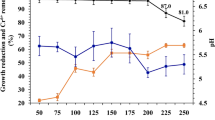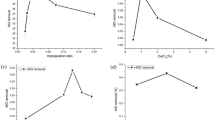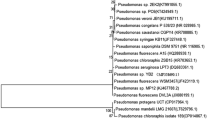Abstract
Pseudomonas MGF-48, a gram-negative, motile, oxidase-negative, catalase-positive, yellow-pigmented bacterium isolated from electroplating effluent, was found to accumulate uranium with high efficiency. Uptake of uranium was rapid and the amount increased in direct proportion to concentration, e.g., from 50 to 200 mg uranium per liter. The largest amount of uranium uptake was 174 mg per gram dry weight bacterial biomass and was observed to occur in stationary phase during incubation at 30 °C. Uptake was determined by flow injection analysis. Maximum uranium accumulation occurred at pH 6.5, with 86% of the uranium being taken up within 5 min of incubation. Release of uranium bound to the cells was accomplished by addition of sodium carbonate and EDTA solution (0.1 M), the cells were reusable, and served as a biosorbent. Cells immobilized in polyacrylamide gel took up 90% of the uranium. Pseudomonas MGF-48 showed excellent efficiency in biosorbing uranium, by both immobilized and free cells. The results of this study, compared with those of other reports of uranium accumulation by microorganisms, leads us to conclude that Pseudomonas MGF-48 shows excellent potential for bioremediating uranium-polluted aqueous effluents.
Similar content being viewed by others
References
Douglas, S. & Beveridge, T.J. 1998 Mineral formation by bacteria in natural microbial communities. FEMS Microbiology Ecology 26, 79–88.
Figueira, M.M., Volesky, B. & Ciminelli, V.S.T. 1997 Assessment of interference in biosorption of a heavy metal. Biotechnology and Bioengineering 54, 344–350.
Higham, D.P., Sadler, P.J. & Scawen, M.D. 1985 Cadmium resistance in Pseudomonas putida: growth and uptake of cadmium. Journal of General Microbiology 131, 2539–2544.
Krieg, N.R. & Holt, J.G. 1984 Bergey's Manual of Systematic Bacteriology, 9th edn., vol. 1. Baltimore, MD, USA: Williams & Wilkins. ISBN 0-683-04108-8.
Lovely, D.R. & Phillips, E.J.P. 1992 Reduction of uranium by Desulfovibrio desulfuricans. Applied and Environmental Microbiology 58, 850–856.
Lovely, D.R., Phillips, E.J.P., Gorby, Y.A. & Landa, E.R. 1991 Microbial reduction of uranium. Nature 350, 413–416.
Lovely, D.R., Widman, P.K., Woodward, J.C. & Phillips, E.J.P. 1993 Reduction of uranium by cytochrome c3 of Desulfovibrio vulgaris. Applied and Environmental Microbiology 59, 3572–3576.
Macaskie, L.E. 1991 The application of biotechnology to the treatment of wastes produced from the nuclear fuel cycle: biodegradation and bioaccumulation as a means of treating radionuclide-containing streams. CRC Critical Reviews in Biotechnology 11, 41–112.
Macaskie, L.E. & Dean, A.C.R. 1984 Cadmium accumulation by a Citrobacter sp. Journal of General Microbiology 130, 53–62.
Malone, C.R. 1989 The Yucca Mountain Project storage problems of high level radioactive waste. Environmental Science and Technology 23, 1452.
Marques, A.M., Roca, X., Simon-Pujol, M.D., Fuste, M.C. & Congregado, F. 1991 Uranium accumulation by Pseudomonas spp. EPS 5028. Applied Microbiology and Biotechnology 35, 406–410.
McLean, R.J.C., Fortin, D. & Brown, D.A. 1996 Microbial metalbinding mechanisms and their relation to nuclear waste disposal. Canadian Journal of Microbiology 42, 392–400.
Mullen, M.D., Wolf, D.C., Ferris, F.G., Beveridge, T.J., Fleming, C.A. & Bailey, G.W. 1989 Bacterial sorption of heavy metals. Applied and Environmental Microbiology 55(12), 3143–3149.
Nakajima, A. & Sakaguchi, T. 1986 Selective accumulation of heavy metals by microorganisms. Applied Microbiology and Biotechnology 24, 59–64.
Niu, H., Xu, X.S. & Wang, J.H. 1993 Removal of lead from aqueous solutions by penicillin biomass. Biotechnology and Bioengineering 42, 785–787.
Norberg, A. & Persson, H. 1984 Accumulation of heavy metals ions by Zoogloea ramigera. Biotechnology and Bioengineering 26, 239–246.
Phillips, E.J.P., Landa, E.R. & Lovely, D.R. 1995 Remediation of uranium contaminated soils with bicarbonate extraction and microbial uranium(VI) reduction. Journal of Industrial Microbiology 14, 203–207.
Pieper, D.H. & Reineke, W. 2000 Engineering bacteria for bioremediation. Current Opinion in Biotechnology 11, 262–270.
Sanchez, A., Ballester, A., Blazquez, M.L., Gonzalez, F., Munoz, J. & Hammaini, A. 1999 Biosorption of copper and zinc by Cymodocea nodosa. FEMS Microbiology Reviews 23, 527–536.
Sar, P., Kazy, S.K., Asthana, R.K. & Singh, S.P. 1998 Nickel uptake by Pseudomonas aeruginosa: role of modifying factors. Current Microbiology 37, 306–311.
Scott, J.A., Palmer, S.J. & Ingham, J. 1986 Decontamination of liquid streams containing cadmium by biomass adsorption. Journal of Chemical Engineering Symposium 96, 211–220.
Silver, S. 1992 Plasmid determined metal resistance mechanisms - range and overview. Plasmid 27, 1–3.
Simmons, P., Tobin, J.M. & Singleton, F.L. 1995 Consideration of the use of commercially available yeast biomass for the treatment of metal containing effluents. Journal of Industrial Microbiology 14, 240–246.
Strandberg, G.W., Shumate, S.E. & Parrot, J.R. 1981 Microbial cells as biosorbents for heavy metals: accumulation of uranium by Saccharomyces cerevisiae and Pseudomonas aeruginosa. Applied and Environmental Microbiology 41, 237–245.
Suttleworth, K.L. & Unz, R.F. 1993 Sorption of heavy metals to the filamentous bacterium Thiothrix strain Al. Applied and Environmental Microbiology 59(5), 1274–1282.
Wong, P.K. & So, C.M. 1993 Copper accumulation by a strain of Pseudomonas putida. Microbios 73, 113–121.
Wong, P.K., Lam, K.C. & So, C.M. 1993 Removal and recovery of Cu(II) from industrial effluuent by immobilization cells of Pseudomonas putida II-11. Applied Microbiology and Biotechnology 39, 127–131.
Author information
Authors and Affiliations
Rights and permissions
About this article
Cite this article
Malekzadeh, F., Farazmand, A., Ghafourian, H. et al. Uranium accumulation by a bacterium isolated from electroplating effluent. World Journal of Microbiology and Biotechnology 18, 295–302 (2002). https://doi.org/10.1023/A:1015215718810
Issue Date:
DOI: https://doi.org/10.1023/A:1015215718810




